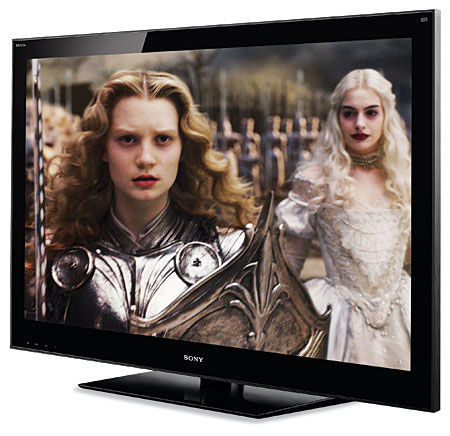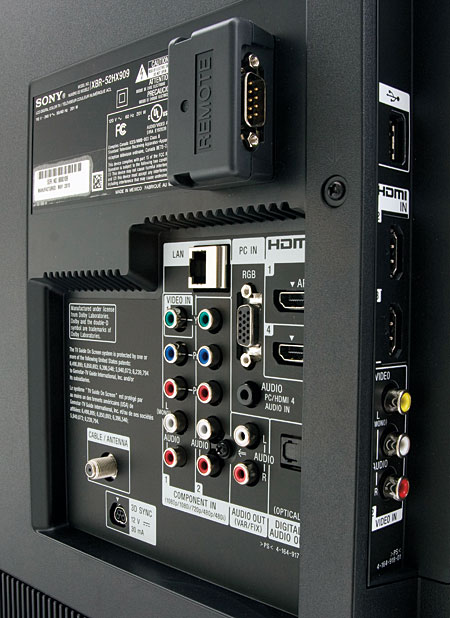Sony BRAVIA XBR-52HX909 LCD 3D HDTV Page 2
There are four preset Color Temperature settings in the Custom mode, but only Warm 2 is close to the D65 video standard. White Balance controls (available in the recommended Picture Modes) provide high and low red, green, and blue settings for color calibration.

The Sony doesn’t offer a user color management system, but I didn’t miss it. Sony is one of the few manufacturers (in our recent experience) that provide an accurate color gamut out of the box. A Color Matrix control lets you manually select the color gamut for each input resolution, but the default settings—ITU709 (Rec. 709) for HD material, ITU601 (Rec. 601) for SD—should work best most of the time.
I found that the Black Corrector control was useful in its Low position, where it added a little richness to near-black details without crushing them. The Detail Enhancer was very subtle, and even in High, it didn’t negatively affect the image. The set’s other enhancement features often did more harm than good and were best left off or in their default positions (see HomeTheaterMag.com for our optimal settings).
Not all 3D sets have a 2D-to3D conversion mode, but the Sony does. It provides a subtle 3D effect from some 2D sources, but this benefit was outweighed by the loss of brightness inherent in 3D. For 3D sources, the sacrifice of brightness was a fair tradeoff. One genuine benefit from this conversion mode is that it activates the 3D glasses with 2D test patterns. This makes it possible to perform a separate 3D calibration with 2D test patterns if you position one of the eyepieces of the 3D glasses in front of the colorimeter.
Motionflow is Sony’s 240-hertz, motion-blur-reducing feature. When engaged (in 2D), Motionflow adds nine interpolated frames to each real frame of a 1080p/24 source to bring the onscreen refresh rate up to 240 Hz. With a 1080p/60 source, it adds three interpolated frames to reach the magic 240 Hz. If the source is 1080i/30, the Sony deinterlaces it to 1080p/60 prior to interpolation. If Motionflow is off, the added frames are still required, but they are repeated, not interpolated.
On film-based material, Motionflow’s effect is most obvious when the separate CineMotion control is in Auto 1. On video-based material, CineMotion had little or no effect on Motionflow. I don’t like what these motion-smoothing features (Sony’s or anyone else’s) do to the look of film, so I left it off. (Out of the box in 2D, Motionflow is engaged by default; in the 3D Vivid and Standard modes, it cannot be turned off.)
The side and rear jack packs include four HDMI ports, a single analog component input, two composite inputs (one of them shared with component), and no S-video. There’s a USB jack for playing back photos, music, and videos from USB-compatible storage devices and a LAN terminal for a home network/Internet connection.

The set also offers a picturein-picture option, Internet features with access to a wide range of Sony-partnered sites, and the ability to connect to your home network either wired or wirelessly—the latter with a separately purchased Sony Wi-Fi adapter. You can also view video and photos or listen to music that comes to the set from your network or over a USB storage device.
Sony’s XMB (XrossMediaBar) menu system has won awards, but I’ve always found it tedious to use—at least until it becomes familiar. A separate Options menu lets you bypass the XMB and get to most of the useful controls, including the picture adjustments. Other than basic connections and the most rudimentary setup guidelines, Sony’s 21-page owner’s manual offers no details about how or why you might want to use any of these adjustments or the set’s other features. An onscreen i-Manual discusses some of the features more thoroughly, but it’s still skimpy on specifics when it comes to the picture.
 The remote is backlit, but the lighting only outlines the buttons and does not illuminate the lettering. You can see where the buttons are in the dark, but not what they do. There are no direct input access buttons, but the remote’s Input button brings up a list of the inputs and cycles only through the active ones.
The remote is backlit, but the lighting only outlines the buttons and does not illuminate the lettering. You can see where the buttons are in the dark, but not what they do. There are no direct input access buttons, but the remote’s Input button brings up a list of the inputs and cycles only through the active ones.
The Sony’s onboard audio is no substitute for a good external sound system, but it’s average for a flat-panel display, and it’s tolerable at modest listening levels.
Video Processing and 2D
The XBR-52HX909 performed satisfactorily on our HD Video Test Bench checks (see chart). It stumbled on horizontal chroma (color) resolution (1080p) at the highest frequency burst. The Auto setting of the so-called RGB Dynamic Range extended the dark end of the brightness range low enough to set the Brightness control properly, but it didn’t go below black (it did go above white, which is more critical with program material, but it still rates a failure score for video clipping).
The Wonderland scenes in Tim Burton’s Alice in Wonderland looked spectacular on the Sony. Its retrieval of detail and color were outstanding. Other stellar Blu-ray transfers, such as Baraka and Seven Years in Tibet, never left me wanting for more resolution or better color.
I was particularly impressed by the Blu-ray release of How the West Was Won. It’s hard to believe how well this 58-year-old Cinerama feature has held up (helped, no doubt, by a good restoration). The color from this classic film is exceptional, with particularly good reproduction of greens and fleshtones. Combine all of this with the tremendous depth of focus inherent in the Cinerama filming process, and the result on the Sony was breathtaking. All it lacked was the sheer image size and immersion of a theatrical Cinerama presentation.
I viewed How the West Was Won in a fully darkened room and in normal widescreen form, not the special SmileBox version also included in the box set. Another benefit I observed was the illusion of an image wider than is possible on the Sony’s 45-inch-wide screen. This was clearly thanks to the set’s startlingly deep black level, which rendered the wider-than-normal black bars from the film’s ultrawide aspect ratio (2.89:1) nearly invisible.













































